Letters from Arthur Seaforth Blackburn to his family, 1941 - Part 8
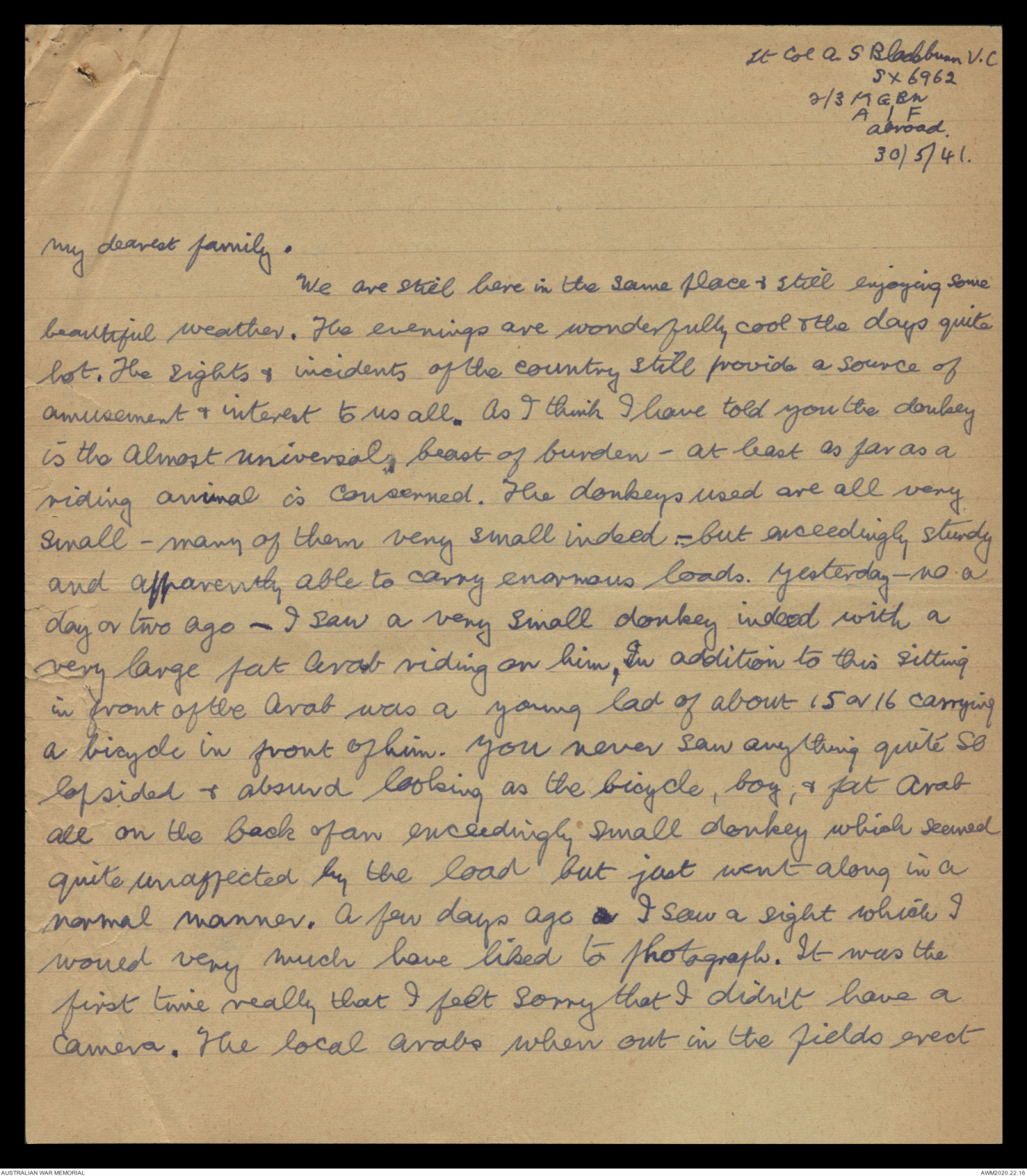
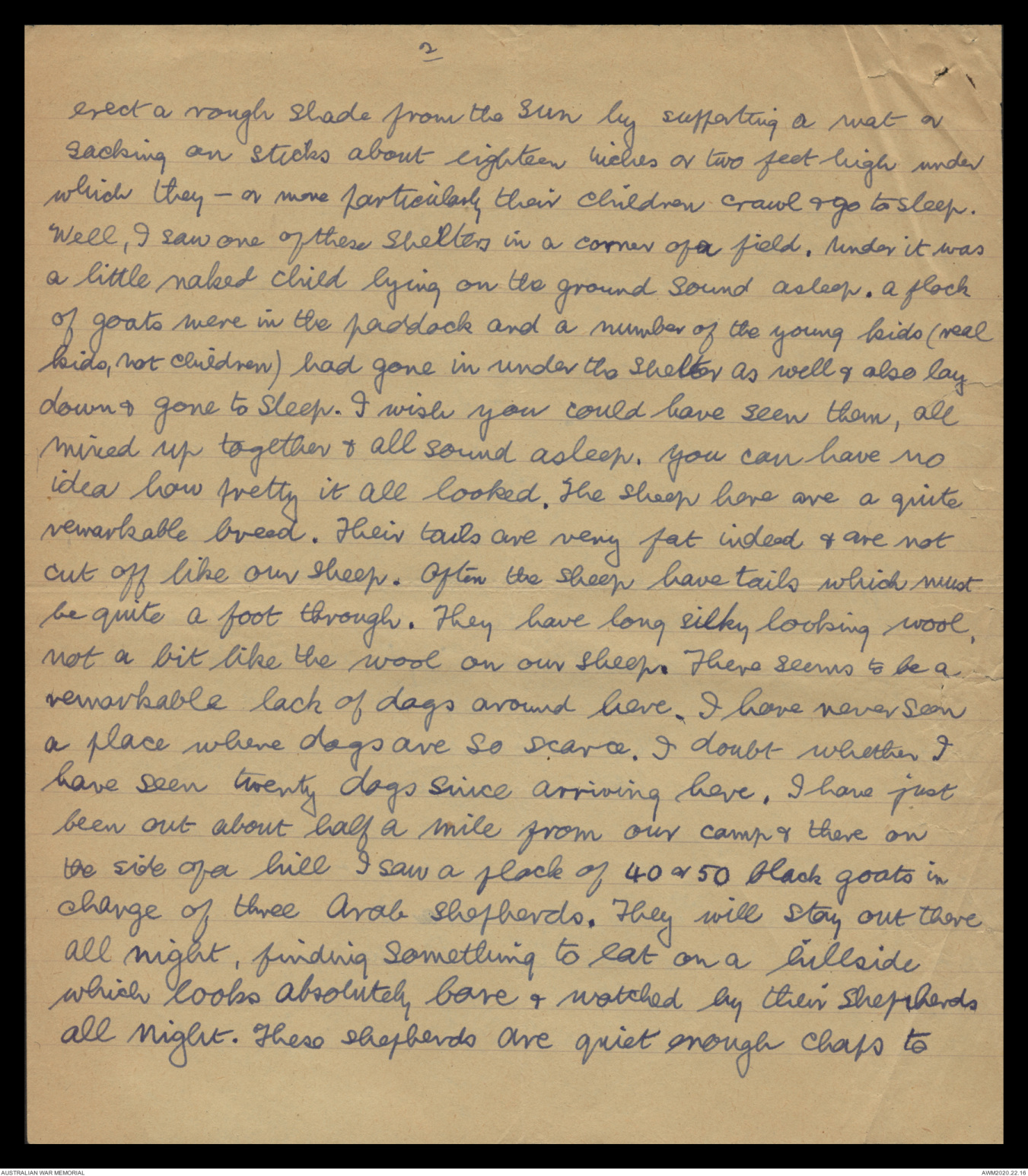
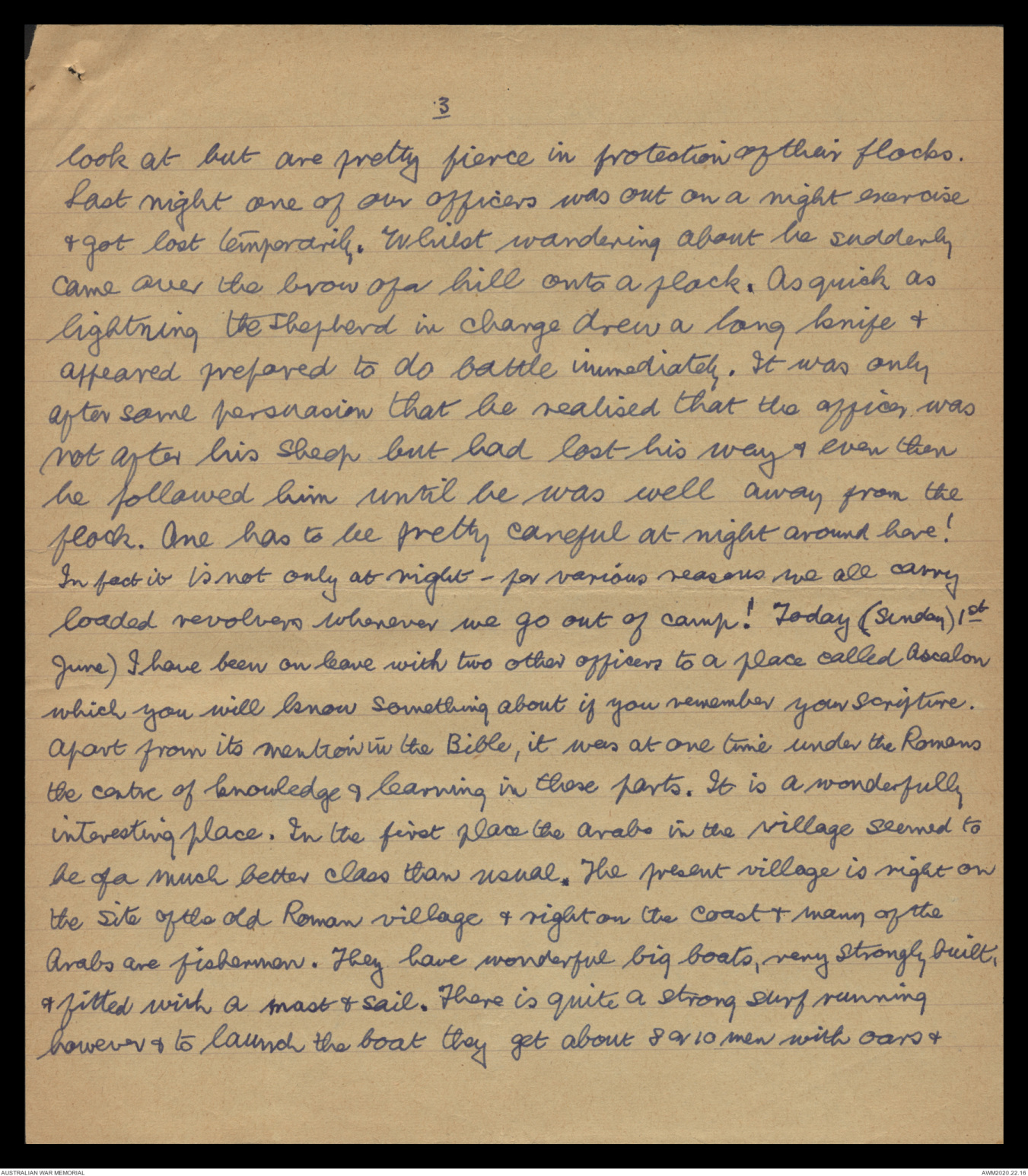
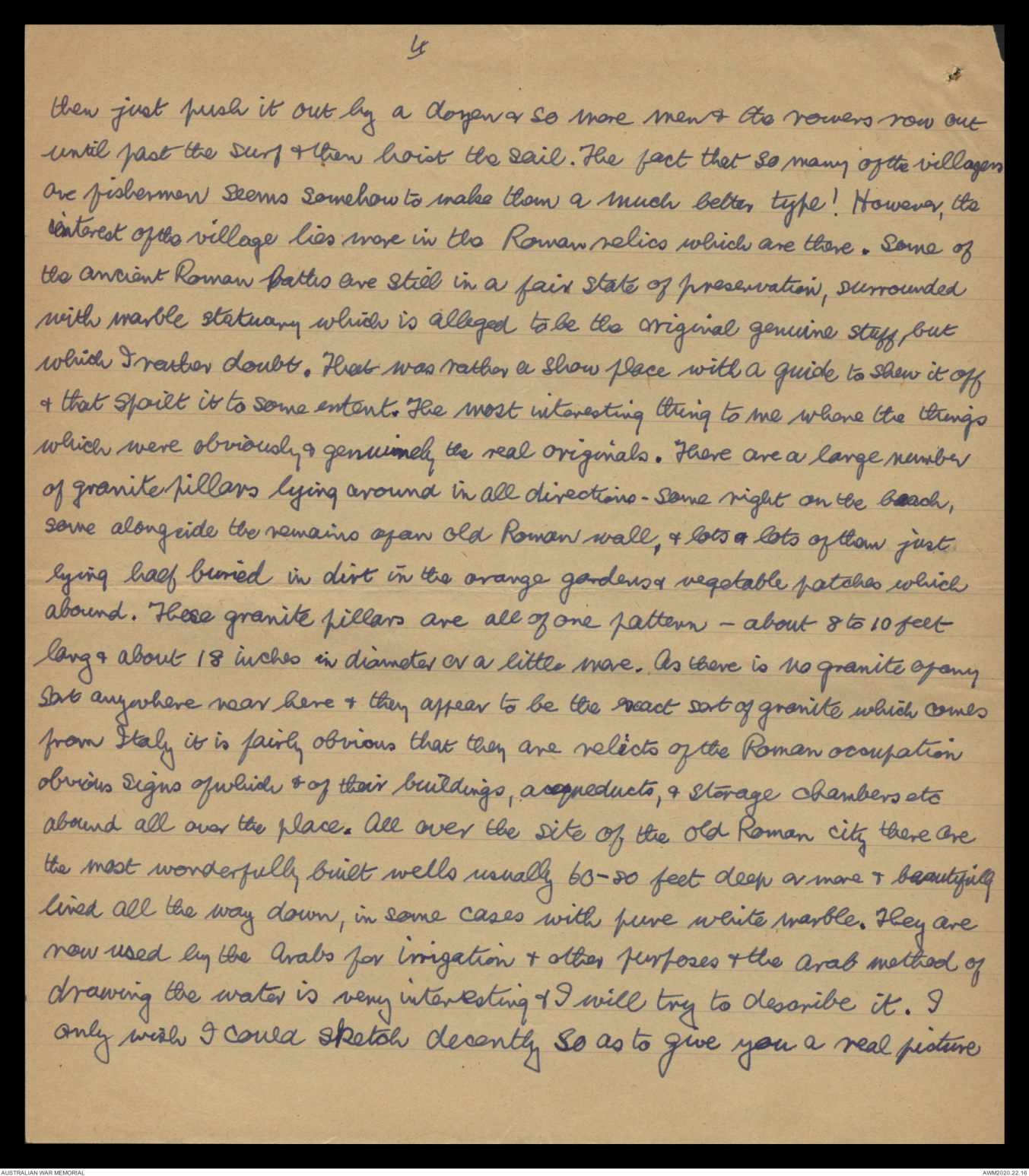
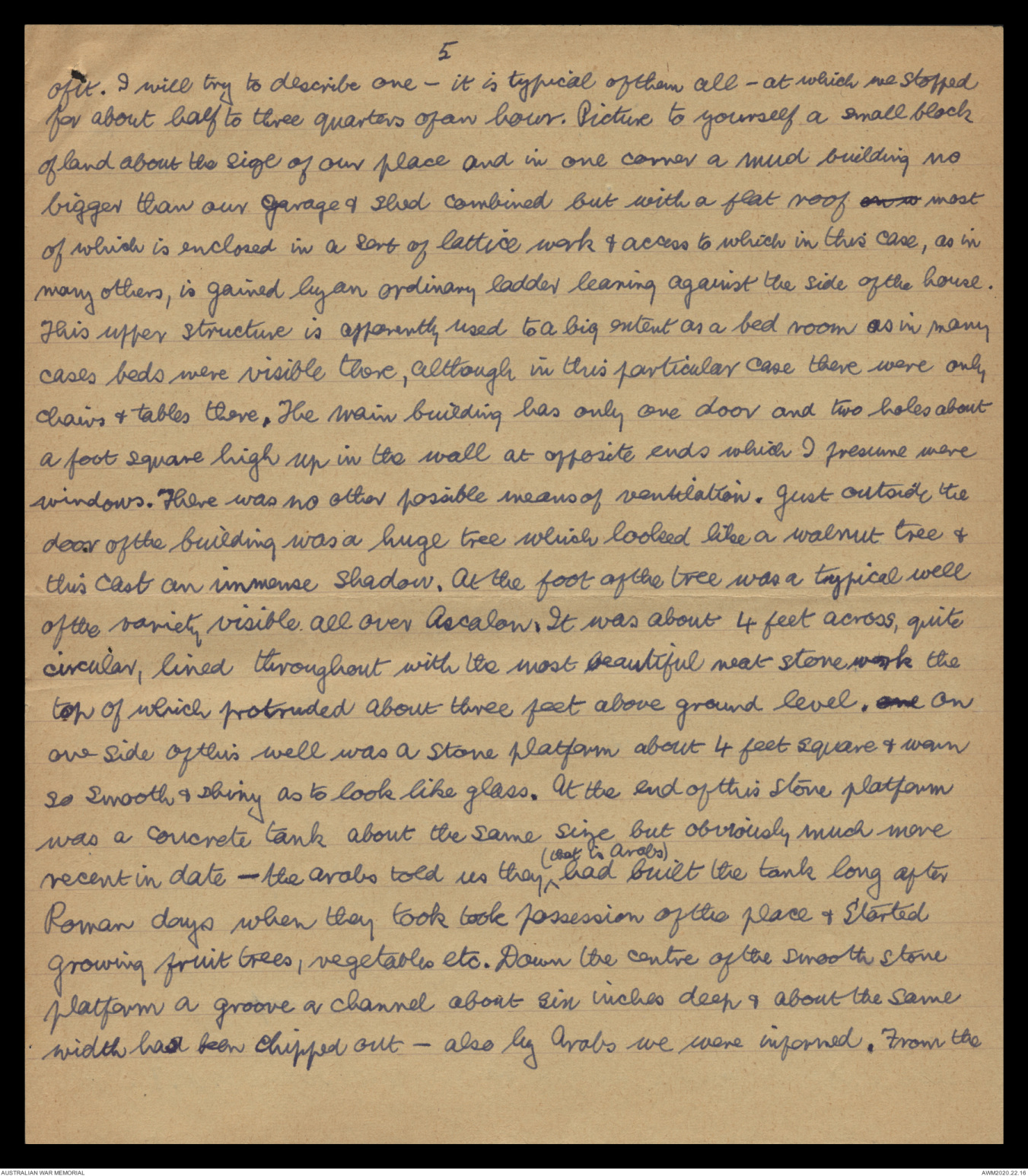
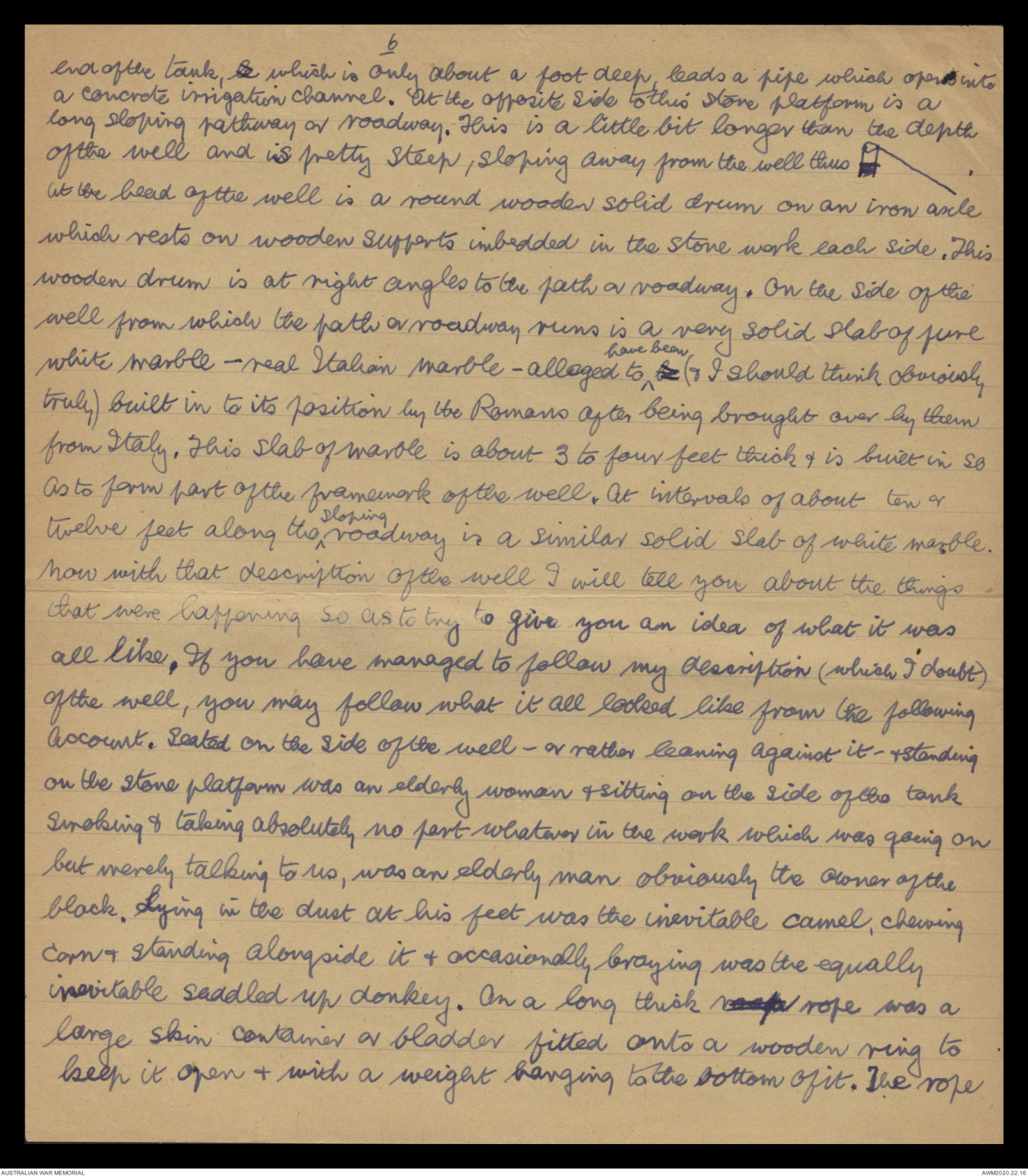

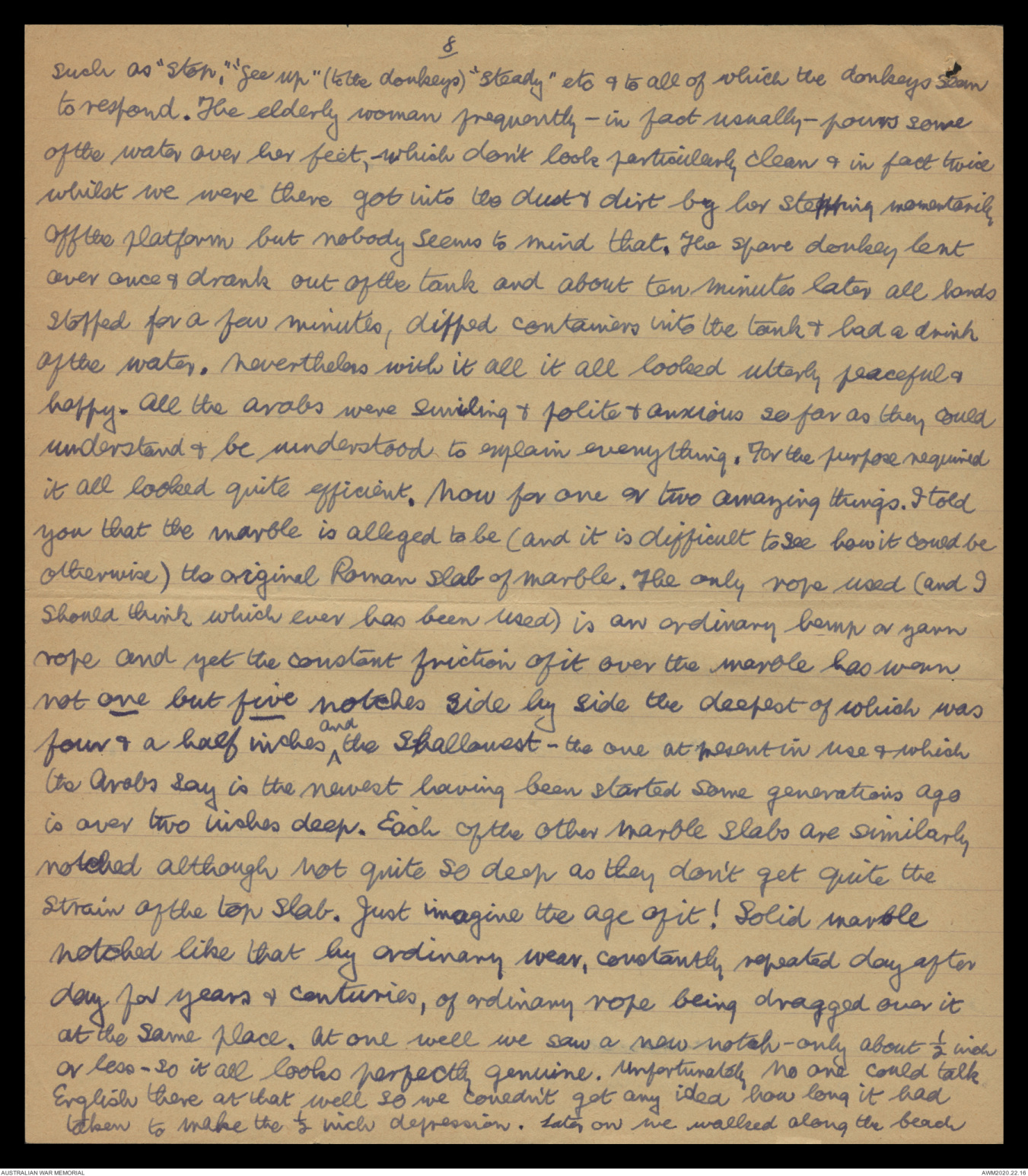
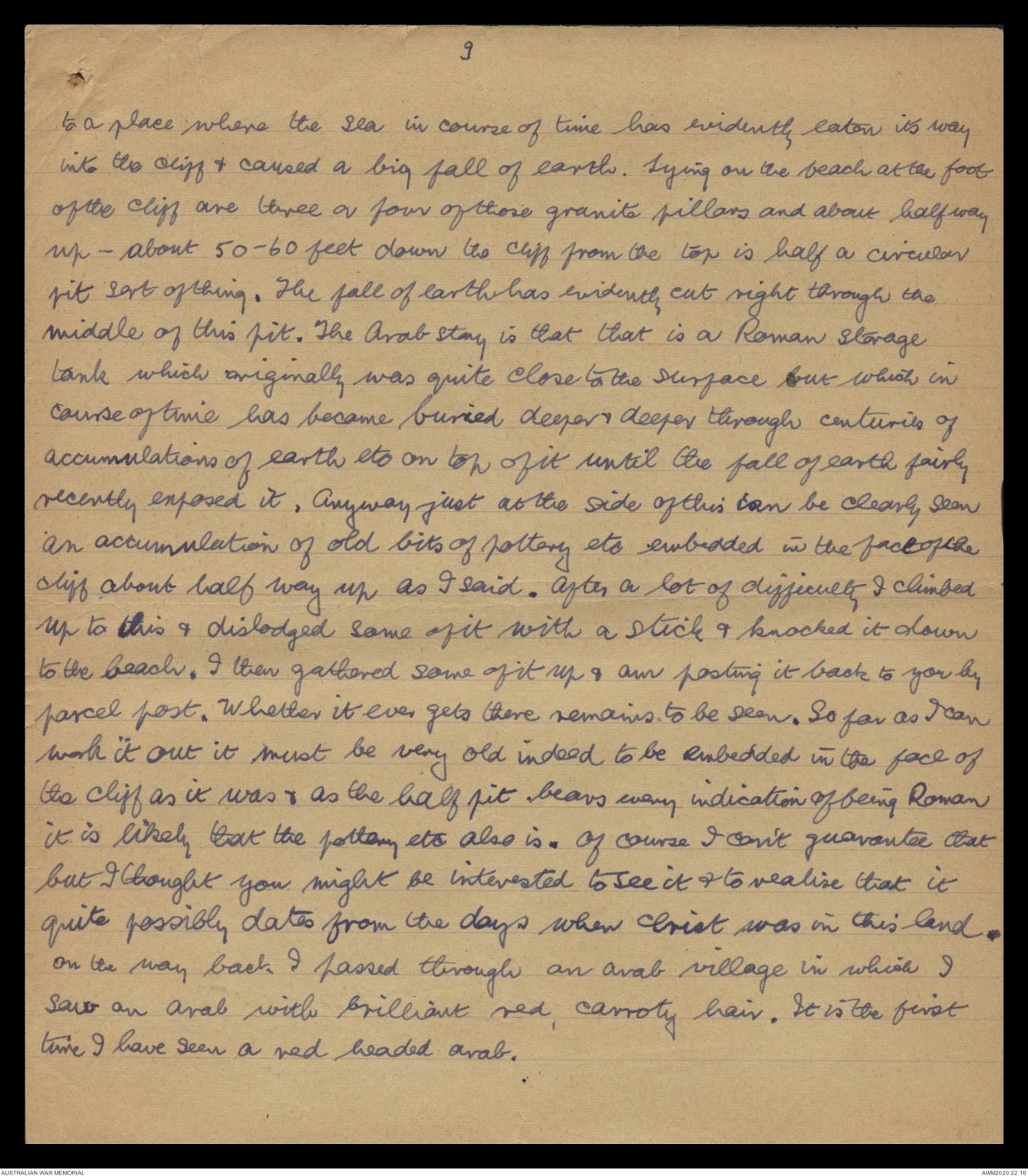
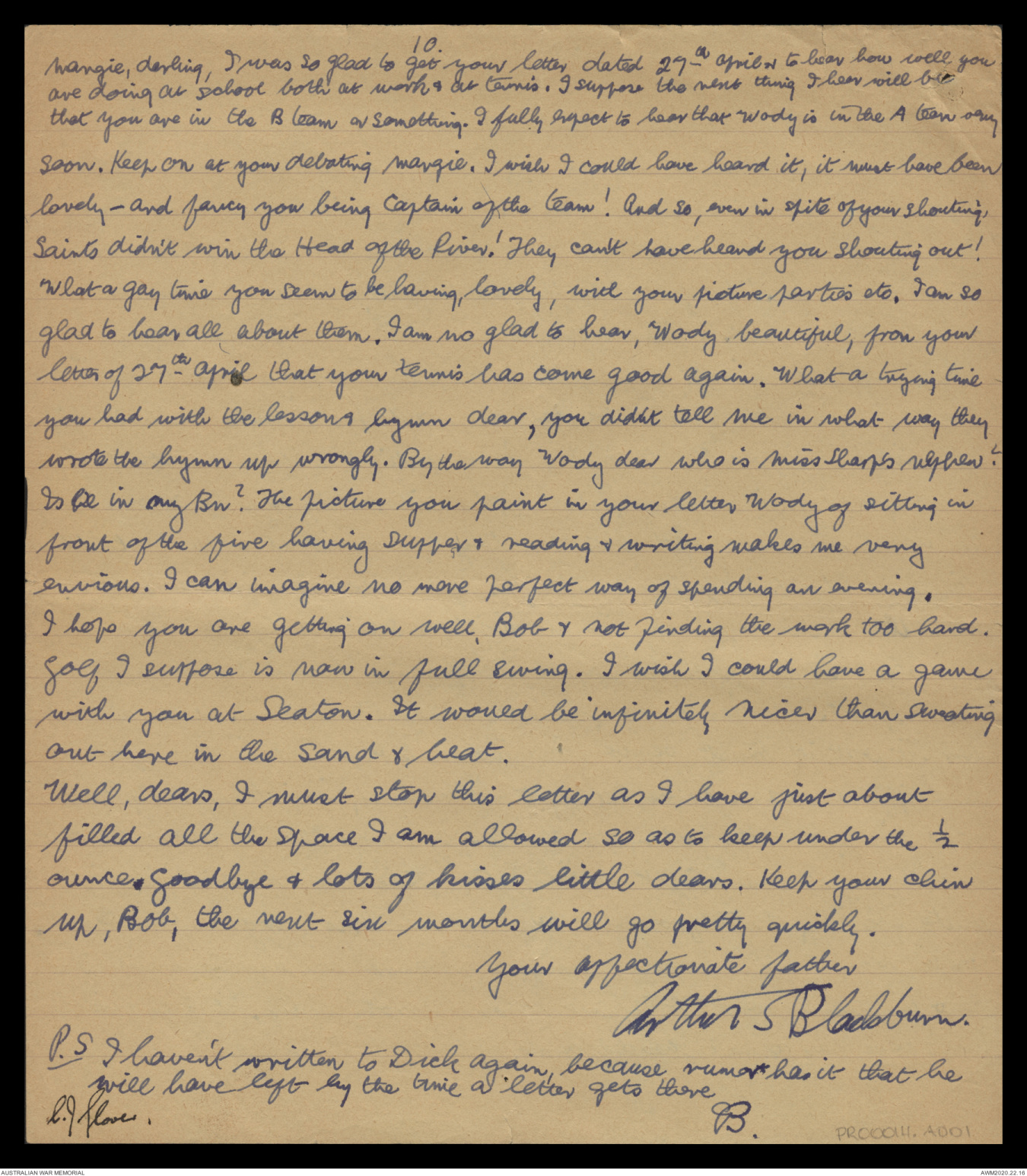
Lt Col A S Blackburn V.C
SX 6962
2/3 M G Bn
AIF
Abroad.
30/5/41.
My dearest family.
We are still here in the same place & still enjoying some
beautiful weather. The evenings are wonderfully cool & the days quite
hot. The sights & incidents of the country still provide a source of
amusement & interest to us all. As I think I have told you the donkey
is the almost universal beast of burden - at least as far as a
riding animal is concerned. The donkeys used are all very
small - many of them very small indeed. - but exceedingly sturdy
and apparently able to carry enormous loads. Yesterday - no a
day or two ago - I saw a very small donkey indeed with a
very large fat Arab riding on him, in addition to this sitting
in front of the Arab was a young lad of about 15 or 16 carrying
a bicycle in front of him. You never saw anything quite so
lopsided & absurd looking as the bicycle, boy, & fat Arab
all on the back of an exceedingly small donkey which seemed
quite unaffected by the load but just went along in a
normal manner. A few days ago a I saw a sight which I
would very much have liked to photograph. It was the
first time really that I felt sorry that I didn't have a
camera. The local Arabs when out in the fields erect
2/
erect a rough shade from the sun by supporting a mat or
sacking on sticks about eighteen inches or two feet high under
which they - or more particularly their children crawl & go to sleep.
Well, I saw one of these shelters in a corner of a field. Under it was
a little naked child lying on the ground sound asleep. A flock
of goats were the paddock and a number of young kids (real
kids, not children) had gone in under the shelter as well & also lay
down & gone to sleep. I wish you could have seen them, all
mixed up together & all sound asleep. You can have no
idea how pretty it all looked. The sheep here are a quite
remarkable breed. Their tails are very fat indeed & are not
cut off like our sheep. Often the sheep have tails which must
be quite a foot through. They have long silky looking wool,
not a bit like the wool on our sheep. There seems to be a
remarkable lack of dogs around here. I have never seen
a place where dogs are so scarce. I doubt whether I
have seen twenty dogs since arriving here. I have just
been out about half a mile from our camp & there on
the side of a hill I saw a flock of 40 or 50 black goats in
charge of three Arab shepherds. They will stay out there
all night, finding something to eat on a hillside
which looks absolutely bare & watched by their Shepherds
all night. These Shepherds are quiet enough chaps to
3/
look at but are pretty fierce in protection of their flocks.
Last night one of our officers was out on a night exercise
& got lost temporarily. Whilst wandering about he suddenly
came over a brow of a hill onto a flock. As quick as
lightning the shepherd in charge drew a long knife &
appeared prepared to do battle immediately. It was only
after same persuasion that be realised that the officer was
not after his sheep but had lost his way & even then
he followed him until he was well away from the
flock. One has to be pretty carefully at night around here!
In fact it is not only at night - for various reasons we all carry
loaded revolvers whenever we go out of camp! Today (Sunday) 1st
June) I have been on leave with two other officers to a place called Ascalon
which you will know something about if you remember your scripture.
Apart from its mention in the Bible, it was at one time under the Romans
the centre of knowledge & learning in these parts. It is a wonderfully
interesting place. In the first place the Arabs in the village seemed to
be of a much better class than usual. The present village is right on
the site of the old Roman village & right on the coast & many of the
Arabs are fishermen. They have wonderful big boats, very strongly built,
& fitted with a mast & sail. There is quite a strong surf running
however & to launch the boat they get about 8 or 10 men with oars &
4/
then just push it out by a dozen or so men & the rowers row out
until past the surf & then just hoist the sail. The fact that so many of the villagers
are fishermen seems somehow to make them a much better type! However, the
interest of the village lies more in the Roman relics which are there. Some of
the ancient Roman baths are still in a fair state of preservation, surrounded
with marble statuary which is alleged to be the original genuine stuff, but
which I rather doubt. That was rather a show place with a guide to show it off
& that spoilt it to some extent. The most interesting thing to me where the things
which were obviously & genuinely the real originals. There are a large number
of granite pillars lying around in all directions - some right on the beach,
some alongside the remains of an old Roman wall, & lots & lots of them just
lying half buried in dirt in the orange gardens & vegetable patches which
abound. These granite pillars are all of one pattern - about 8 to 10 feet
long & about 18 inches in diameter or a little more. As there is no granite of any
sort anywhere near here & they appear to be the exact sort of granite which comes
from Italy it is fairly obvious that they are relicts of the Roman occupation
obvious signs of which & of their buildings, acqueducts, & storage chambers etc
abound all over the place. All over the site of the old Roman city there are
the most wonderfully built wells usually 60-80 feet deep or more & beautifully
lined all the way down, in some cases with pure white marble. They are
now used by the Arabs for irrigation & other purposes & the Arab method of
drawing the water is very interesting & I will try to describe it. I
only wish I could sketch decently so as to give you a real picture
5/
of it. I will try o describe one - it is typical of them all - at which we stopped
for about half to three quarters of an hour. Picture to yourself a small block
of land about the size of our place and in one corner a mud building no
bigger than our garage & shed combined but with a flat roof on w most
of which is enclosed in a sort of lattice work & access to which in this case, as in
many others, is gained by an ordinary ladder leaning against the side of the house.
This upper structure is apparently used to a big extent as a bed room as in many
cases beds were visible there, although in this particular case there were only
chairs & tables there. The main building has only one door and two holes about
a foot square high up in the wall at opposite ends which I presume were
windows. There was no other possible means of ventilation. Just outside the
door of the building was a huge tree which looked like a walnut tree &
this cast an immense shadow. At the foot of the tree was a typical well
of the variety visible all over Ascalon. It was about 4 feet across, quite
circular, lined throughout with the most beautiful neat stonework the
top of which protruded about three feet above ground level. One On
one side of this well was a stone platform about 4 feet square & worn
so smooth & shiny as to look like glass. At the end of this stone platform
was a concrete tank about the same size but obviously much more
recent in date - the Arabs told us they (that is Arabs) had built the tank long after
Roman days when they took took possession of the place & started
growing fruit trees, vegetables etc. Down the centre of the smooth stone
platform a groove or channel about six inches deep & about the same
width has been chipped out - also by Arabs we were informed. From the
6/
end of the tank, le which is only about a foot deep, leads a pipe which opens into
a concrete irrigation channel. At the opposite side to this stone platform is a
long sloping pathway or roadway. This is a little bit longer than the depth
of the well and is pretty steep, sloping away from the well thus. [Illustration of well].
At the head of the well is a round wooden solid drum on an iron axle
which rests on wooden supports imbedded in the stone work each side. This
wooden drum is at right angles to the path or roadway. On the side of the
well from which the path or roadway runs is a very solid slab of pure
white marble - real Italian marble - alleged to have been be (& I should think obviously
truly) built in to its position by the Romans after being brought over by them
from Italy. This slab of marble is about 3 to four feet think & is built in so
as to form part of the framework of the well. At intervals of about ten or
twelve feet along the sloping roadway is a similar solid slab of white marble.
Now with that description of the well I will tell you about the things
that were happening so as to try to give you an idea of what it was
all like. If you have managed to follow my description (which I doubt)
of the well, you may follow what it all looked like from the following
account. Seated on the side of the well - or rather leaning against it - & standing
on the stone platform was an elderly woman & sitting on the side of the tank
smoking & taking absolutely no part whatever in the work which was going on
but merely talking to us, was an elderly man obviously the owner of the
block. Lying in the dust at his feet was the inevitable camel, chewing
corn & standing alongside it & occasionally braying was the equally
inevitable saddled up donkey. On a long thick roap rope was a
large skin container or bladder fitted onto a wooden ring to
keep it open & with a weight hanging to the bottom of it. The rope
7/
passes over the wooden drum - on over the marble slab and to a
yoke to which are harnessed two donkeys. A much younger man
& woman - and three children - (they looked like son in laws & wife or vice
versa) were in charge of the donkeys. Now the elderly woman drops the
skin containers into the well, the donkeys at this time being right up at
the top of the sloping roadway alongside the well. When the rope is
taut - which means it has reached the bottom of the well - the donkeys
proceeded to walk away down the sloping roadway. The strain on the
rope goes on, the rope passed over the wooden drum which revolves,
then passes over the marble slab (with the strain of the weight of water
pressing it against the marble) and as the donkeys move further &
further away passes over successive marble slabs. The rope is so
arranged - or perhaps I should say that the roadway is so arranged in length
that when the donkeys reach the bottom end of it (where a wall of
solid earth automatically stops them) the skin container has been drawn
up - full of water of course - to the level of the stone platform. The
elderly woman then ceased grabbed it, & tipped it out onto the platform
where it ran down the groove or channel & so out into the tank.
Immediately the elderly woman drops the container back into the well,
the donkeys turn & walk up to the well again, thus lowering the
container again to the bottom of the well & so the performance goes
on & on until enough water is drawn. All this is done to the
accompaniment of a regalmained not at all unpleasant sort of sing song
from everyone concerned, all of which seems to mean the different "orders"
8/
such as "stop," "gee up" (to the donkeys) " steady" etc & to all of which the donkeys seem
to respond. The elderly woman frequently - in fact usually - pours some
of the water over her feet, - which don't look particularly clean & in fact twice
whilst we were there got into the dust & dirt by her stepping momentarily
off the platform but nobody seems to mind that. The spare donkey lent
over once & drank out of the tank and about ten minutes later all hands
stopped for a few minutes, dipped containers into the tank & had a drink
of the water. Nevertheless with it all it all looked utterly peaceful &
happy. All the Arabs were smiling & polite & anxious so far as they could
understand & be understood to explain everything. For the purpose required
it all looked quite efficient. Now for one or two amazing things. I told
you that the marble is alleged to be (and it is difficult to see how it could be
otherwise) the original Roman slab of marble. The only rope used (and I
should think which ever has been used) is an ordinary hemp or yarn
rope and yet the constant friction of it over the marble has worn
not one but five notches side by side the deepest of which was
four & a half inches and the shallowest - the one at present is use & which
the Arabs say is the newest having been started some generations ago
is over two inches deep. Each of the other marble slabs are similarly
notched although not quite so deep as they don't get quite the
strain of the top slab. Just imagine the age of it! Solid marble
notched like that by ordinary wear, constantly repeated day after
day for years & centuries, of ordinary rope being dragged over it
at the same place. At one well we saw a new notch - only about ½ inch
or less - so it all looks perfectly genuine. Unfortunately no one could talk
English there at that well so we couldn't get any idea how long it had
taken to make the ½ inch depression. Later on we walked along the beach
9/
to a place where the sea in course of time has evidently eaten it's way
into the cliff & caused a big fall of earth. Lying on the beach at the foot
of the cliff are three or four of those granite pillars and about halfway
up - about 50 - 60 feet down the cliff from the top is half a circular
pit sort of thing. The fall of earth has evidently cut right through the
middle of the pit. The Arab story is that that is a Roman storage
tank which originally was quite close to the surface but which in
course of time has become buried deeper & deeper through centuries of
accumulations of earth etc on top of it until the fall of earth fairly
recently exposed it. Anyway just at the side of this can be clearly seen
an accumulation of old bits of pottery etc embedded in the face of the
cliff about half way up as I said. After a lot of difficulty I climbed
up to this & dislodged some of it with a stick & knocked it down
to the beach. I then gathered some of it up & am posting it back to you by
parcel post. Whether it ever gets there remains to be seen. So far as I can
work it out it must be very old indeed to be embedded in the face of
the cliff as it was & as the half pit bears every indication of being Roman
it is likely that the pottery etc also is. Of course I can't guarantee that
but I thought you might be interested to see it & to realise that it
quite possibly dates from the days when Christ was in this land.
On the way back I passed through an Arab village in which I
saw an Arab with brilliant red, carroty hair. It is the first
time I have seen a red headed Arab.
10.
Margie, darling, I was so glad to get your letter dated 29th April & to hear how well you
are doing at school both at work & at tennis. I suppose the next thing I hear will be
that you are in the B team or something. I fully expect to hear that Wody is in the A team very
soon. Keep on at your debating Margie. I wish I could have heard it, it must have been
lovely - and fancy you being Captain of the team! And so, even in spite of your shouting,
Saints didn't win the Head of the River! They can't have heard you shouting out!
What a gay time you seen to be having, lovely, with your picture parties etc. I am so
glad to hear all about them. I am no glad to hear, Wody beautiful, from your l
etter of 27th April that your tennis has come good again. What a trying time
you had with the lesson & hymn dear, you didn't tell me in what way they
wrote the hymn up wrongly. By the way Wody dear who is Miss Sharp's nephew?
Is he is my Bn? The picture you paint in your letter Wody of sitting in
front of the fire having supper & reading & writing makes me very
envious. I can imagine no more perfect way of spending an evening.
I hope you are getting on well, Bob & not finding the work too hard.
Golf I suppose is in full swing. I wish I could have a game
with you at Seaton. It would be infinitely nicer than sweating
out here in the sand & heat.
Well, dears, I must stop this letter as I have just about
filled up all the space I am allowed so as to keep under the ½
ounce. Goodbye & lots of kisses little dears. Keep your chin
up, Bob, the next six months will go pretty quickly.
Your affectionate father
Arthur S Blackburn.
P.S I haven't written to Dick again, because rumor has it that he
will have left by the time a letter gets there.
AB.
C.J Glover.
 Jacqueline Kennedy
Jacqueline KennedyThis transcription item is now locked to you for editing. To release the lock either Save your changes or Cancel.
This lock will be automatically released after 60 minutes of inactivity.